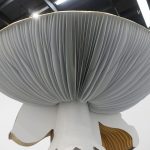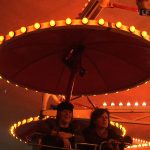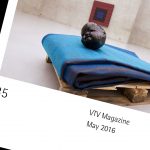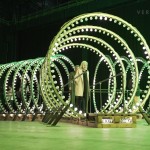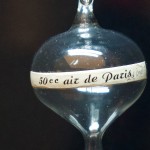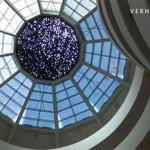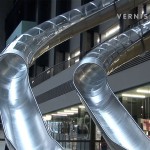In October 2006, artist Carsten Höller installed five large slides in the Turbine Hall of Tate Modern in London. The visitors of the museum had the chance to hurtle down these silver slides and experience a feeling of letting go and losing control. The longest slide was 55,5 meters long and dropped 26,5 meters from level five of the building to the Turbine Hall floor. The above video takes you an a glissade through this slide.
This is another segment in our series r3 that highlights the treasures of VernissageTV’s huge archive. R3 is a series of VernissageTV classics, now re-mastered, re-edited and reissued in High Definition. Click here for the complete list of videos. Click here for the original post. For more videos featuring Carsten Höller, click here!
Video by Arno Dietsche and Heinrich Schmidt.
> Right-click (Mac: ctrl-click) this link to download Quicktime video file.
Press release text by Tate Modern
From today visitors to Tate Modern are able to travel through the vast Turbine Hall on five large slides which spiral through the vast space connecting the galleries with the Hall. Test Site is the latest installation in the Unilever Series at Tate Modern and has been made by German artist Carsten Höller (b. 1961).
The title of the installation, Test Site, relates to both Carsten Höller’s wider interest in the application of slides as a means of human transport and his exploration of how participants might be stimulated. The installation is, in part, an open experiment into the reception of slides by the public and the effect they have on those who use them. While the slides in Tate Modern provide a practical form of transportation, the act of going down involves relinquishing control, inducing a particular state of mind related to freedom from constraint. Höller’s proposition is that slides could and perhaps should be incorporated into existing architecture and the architectural planning of future buildings and public spaces, not only because they offer a clean and efficient means of transport, but because the frequent act of sliding could bring about untold changes in our everyday behaviour and outlook.
The five silver slides produce an extraordinary sculptural form that is suggestive of a futuristic vision of the building’s system of circulating people. Three of the chutes depart from each of Tate Modern’s main gallery levels (Levels 3, 4 and 5) and two chutes depart from each side of the walkway or bridge (Level 2) that cuts through the Turbine Hall. The tubular slides dramatically twist round before landing all at the same place at the bottom of the Turbine Hall (Level 1). The landing point beneath the bridge has been transformed into a brightly lit arrival zone where the sliders’ arrival can be viewed by all.
The longest slide is 55.5 metres and drops 26.5 metres from level five to the Turbine Hall floor. The two smallest twin slides (they have the same length and form, but are built in reverse to mirror each other), both 16 metres long, leave the bridge and drop to the floor 7.5 metres below. All slides have gradients between 30 and 35 degrees. Sliders can test how the quality of sliding is affected by the different shapes.
Well used to working on a large scale, Carsten Höller’s central concerns relate to the concept of the self, the questioning of logic, and the beauty of uncertainty. He considers subjective experience his main working material and his work frequently allows for participation from the viewer. Höller is well known for his interest in and production of slides, an ongoing project since 1998, and he has produced slide installations in Berlin, New York, Helsinki, Milan and Boston. A total of six slides have been built so far. Among his most famous slides is the one he made for the offices of Prada in Milan (2000), which connects Miuccia Prada’s personal office to her car.
The Unilever Series: Carsten Höller Test Site is curated by Jessica Morgan, Curator of Contemporary Art, Tate. It is accompanied by two volumes: an illustrated catalogue The Unilever Series:Carsten Höller Test Site edited by Jessica Morgan with essays by Dorothea von Hantelmann and Roy Kozlovsky. It also contains a proposal for an Hypothetical Slide House commissioned from leading architects Foreign Office Architects and a feasibility study for the use of slides within the urban public arena by General Public Agency. The Unilever Series: Carsten Höller Test Site: Source Book, edited and with a foreword by Carsten Höller, will also accompany the installation and is a collection of texts and images which have inspired and informed the artist in regard to his interest in slides and the effect of sliding.
[…]
